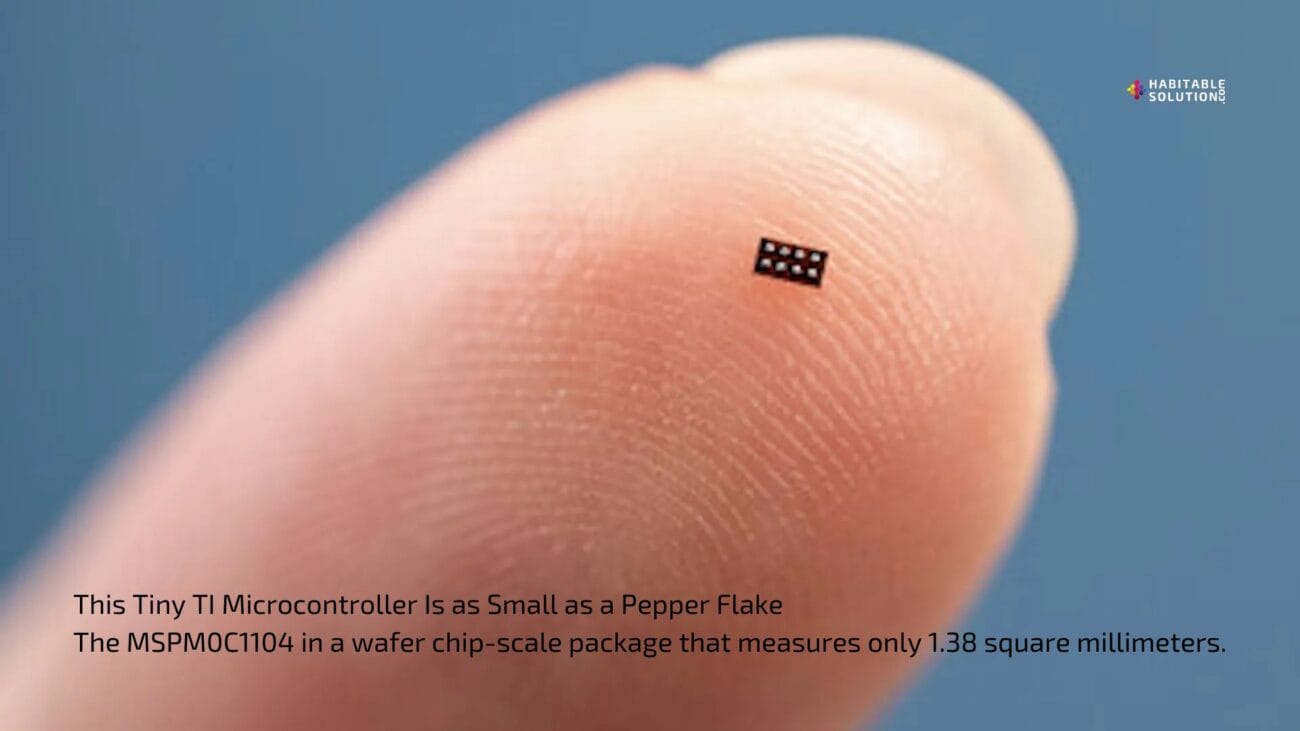Texas Instruments has unveiled an incredibly small microcontroller—about the size of a black pepper flake—designed for compact devices like electric toothbrushes, stylus pens, and wearables.
Measuring just 1.38 square millimeters, this ultra-miniature MCU is part of TI’s Arm Cortex-based embedded lineup. Despite its tiny size, it packs a 12-bit analog-to-digital converter, 16KB of flash memory, 1KB of SRAM, and runs at 24MHz—making it a powerhouse for space-constrained applications.
Officially named the MSPM0C1104 (not the catchiest name, unfortunately), the microcontroller is priced at just 16 cents per unit for bulk orders of 1,000 or more. That means a company could kickstart a fleet of micro-sized robots for as little as $160.
TI is showcasing this cutting-edge MCU, along with other innovations, at Embedded World 2025 in Nuremberg, Germany.
In an age where technology continues to shrink in size but grow in capability, Texas Instruments (TI) has just unveiled something that perfectly captures the future of miniaturized electronics—a microcontroller (MCU) so small, it’s literally about the size of a black pepper flake.
This new microcontroller, officially named the MSPM0C1104, isn’t just a marvel of engineering because of its compact footprint—it’s also a fully functional and surprisingly powerful unit that opens the doors to a wide array of possibilities for developers, engineers, and innovators working on compact and power-efficient devices. Despite being small enough to sit on the tip of a pencil, this chip is packed with robust features that can drive applications ranging from personal care products to wearable technology.
So let’s dive deep into what makes this MCU special, where it could be used, and why this tiny chip could play a huge role in the next wave of smart devices.
How Tiny Are We Talking?
To put its size into perspective, the MSPM0C1104 measures just 1.38 square millimeters. That’s roughly the same size—or even smaller—than a common black pepper flake. This means it could fit comfortably on your fingertip with room to spare.
But unlike that humble flake of spice, this chip houses an entire ecosystem of computing power, including a 12-bit analog-to-digital converter (ADC), 16KB of flash memory, 1KB of SRAM, and a 24MHz clock speed—all running on an Arm Cortex-M0+ core.
This might sound technical, but what it means is that this chip can handle a wide range of tasks while drawing minimal power, making it a perfect fit for applications where both space and energy are limited.
What’s Inside the MSPM0C1104?
TI didn’t just create a tiny chip—they made sure it was highly functional too. Let’s break down its internal capabilities in simpler terms:
- Arm Cortex-M0+ Core @ 24MHz:
The processor core inside this chip is based on Arm’s Cortex-M0+ architecture, which is known for its ultra-low power consumption and solid performance. It’s designed for embedded systems where size, power, and simplicity matter most. - 16KB Flash Memory:
This is where your program code lives. While 16KB may sound small compared to your smartphone’s gigabytes of storage, it’s more than enough for many real-time control tasks such as sensor reading, device communication, or signal processing. - 1KB SRAM:
The chip also includes 1KB of SRAM, which is used for short-term data storage while the microcontroller is running. It’s efficient for small operations that require fast, temporary access to memory. - 12-bit Analog-to-Digital Converter (ADC):
This allows the microcontroller to read analog signals from the real world (like a temperature sensor, light sensor, or pressure sensor) and convert them into digital data for processing. A 12-bit ADC offers decent precision and is a good fit for many practical sensing applications.
Where Can This MCU Be Used?
The MSPM0C1104 isn’t just a showcase of TI’s engineering excellence; it’s also a highly practical component for real-world products. Here are some examples of where this microcontroller could shine:
1. Electric Toothbrushes
The internal electronics in electric toothbrushes need to be compact, efficient, and cost-effective. A microcontroller like the MSPM0C1104 could manage motor control, vibration timing, battery monitoring, and even feedback mechanisms like LED indicators—all within a fraction of the physical and power budget of traditional chips.
2. Stylus Pens
In digital styluses, where every millimeter counts, the MSPM0C1104 can be used to read pressure sensors, tilt inputs, or button presses while ensuring long battery life. Its small footprint allows for sleek, ergonomic pen designs without compromising functionality.
3. Wearables
Fitness trackers, smart rings, and medical wearables often have strict size and power requirements. The MSPM0C1104 provides enough computing power to handle sensors, display output, and even Bluetooth communication while being tiny and energy-efficient.
4. Micro Robots
Think swarms of tiny robots used in agriculture, surveillance, or search-and-rescue missions. With a price of just 16 cents per unit (in orders of 1,000 or more), deploying a large fleet becomes not only possible but cost-effective.
5. IoT Devices
With the rise of the Internet of Things (IoT), there’s a demand for ultra-small controllers that can connect to sensors, gather data, and communicate with larger systems. The MSPM0C1104 is ideal for embedding intelligence into everyday objects—turning them “smart” without the need for bulky or expensive electronics.
Cost Efficiency at Its Core
Let’s talk numbers.
Texas Instruments is offering the MSPM0C1104 at a remarkably low price of $0.16 per unit, provided you’re purchasing in bulk (1,000 units or more). This means an entire batch of 1,000 MCUs will cost just $160—a price point that’s almost unheard of for such functionality.
For startups, R&D teams, and makers, this makes experimentation and prototyping extremely affordable. Whether you’re creating a proof-of-concept wearable or building educational kits for schools, these MCUs bring both performance and accessibility.
Showcased at Embedded World 2025
TI is presenting the MSPM0C1104 and its broader MSPM0 series at Embedded World 2025, one of the most influential trade fairs for embedded systems. Hosted in Nuremberg, Germany, the event attracts developers, researchers, and businesses from around the globe.
The MSPM0 series isn’t just about miniaturization. The whole product line focuses on scalability, power efficiency, and design flexibility—traits that are crucial for engineers working on next-gen embedded systems. The unveiling of the MSPM0C1104 is a statement: the future of embedded computing is both smaller and smarter.
Why This Tiny MCU Matters
The engineering world is constantly pushing for more performance in smaller packages, especially with the rise of wearables, medical tech, and smart home devices. The MSPM0C1104 represents a new standard in how compact a microcontroller can be while still offering real, usable computing power.
Here’s why this chip is a game-changer:
- Encourages Innovative Design:
Designers now have more freedom to create ultra-slim or compact products without compromising on internal intelligence. - Enables Mass Deployment:
With its low cost, companies can integrate smart functionality into large numbers of low-cost devices or even disposable products like smart patches or environmental monitors. - Supports Sustainability Goals:
Smaller devices with lower power consumption can contribute to eco-friendlier tech products, extending battery life and reducing material waste.
Looking Ahead
While the MSPM0C1104 might not make headlines in the mainstream tech world, it represents a quiet but powerful revolution in electronics design. As engineers embrace smaller, smarter components, we’ll start seeing a wave of innovative products that are lighter, cheaper, and more efficient—without sacrificing performance.
In the near future, we might not even notice the MSPM0C1104 doing its job in the devices we wear, hold, or use every day. And maybe that’s the whole point. The best technology often disappears into the background—reliable, efficient, and quietly brilliant.
Explore More:
Want to learn more about TI’s latest innovations or embedded systems development? You can visit Texas Instruments’ official site or attend Embedded World 2025 to experience these technologies firsthand.
Written for Habitable Solution – Simplifying Business with Premium IT Solutions. For more tech news, hardware updates, and product reviews, visit habitablesolution.com or email us at [email protected].






